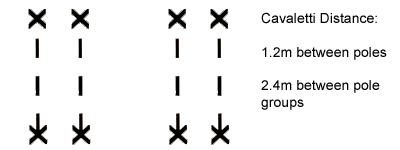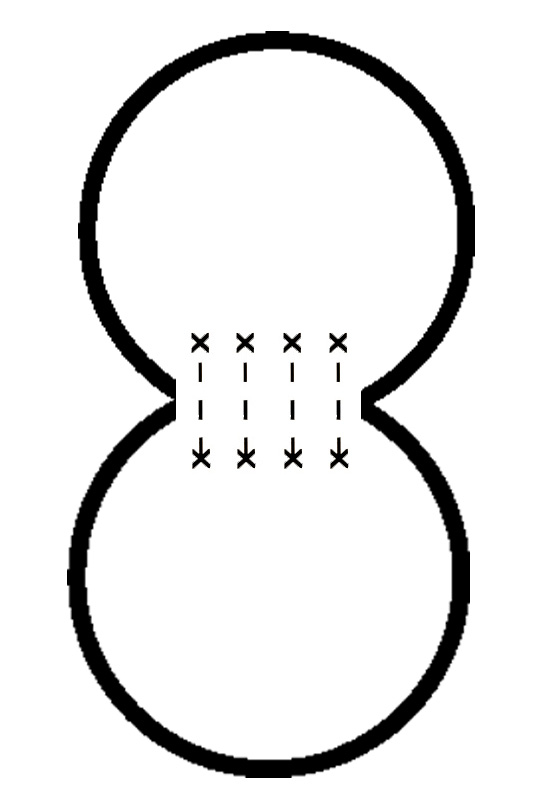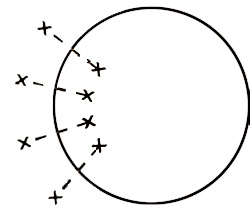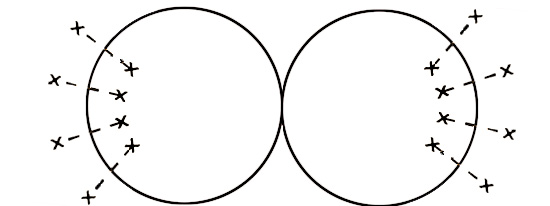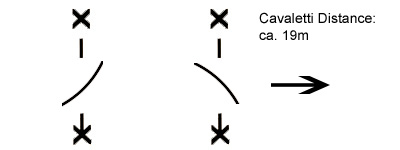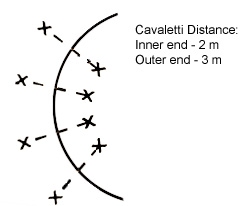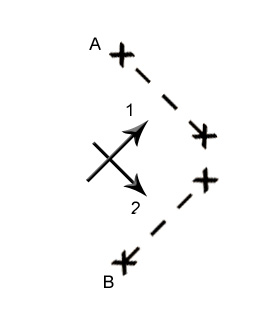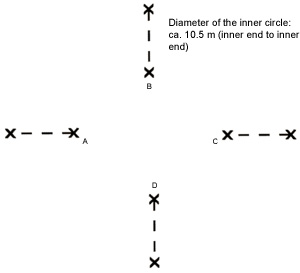AQUILA

... and as I so rode, my heart rang with the grass-hushed steps, rang with the snuffles and bit-play of my Grey, and bliss lit up my heart, and I knew: that if I were to fall out of the world at this moment, I would fall into Heaven. Baron Munchhausen |
Cavaletti Seminar with Ingrid Klimke, 9th November 2009 |
| Back to Current News |
| Introduction |
| Young Horses |
| Medium Horses |
| Advanced Horses |
| Question and Answer session |
|
The seminar Cavaletti for Sport and Recreation Horses was run by the PM (Persönliche Mitglied) of the German FN, and held at the Landeslehrstätte Weser-Ems at Vechta. The PM had selected three pairs of horses:
As far as I am aware, these riders were invited. All were thanked for participating, and given gifts. Ingrid Klimke (IK) mentioned that her preference is for heavy wooden poles for the cavaletti, instead of light plastic or aluminium. When a horse hits a wooden pole with his feet, it is uncomfortable and he learns to avoid this (i.e. pick up his feet, watch where he is going). Some of the lighter poles can be cause injury if they break or shatter. IK prefers to use rounded plastic or metal blocks to put the poles on, as the traditional cross ends (X) can hook up a longeing line if the handler is not careful. It can make things easier if the centre of the pole is marked - sometimes with the painting, there is a coloured stripe in the centre. If you have plain white poles you can run a strip of electrical tape (insulating tape) around the middle (as was done here). This gives the eye something to aim for. IK said that you can start the cavaletti work in the winter when the horse is 3 years old, rising 4 years old, once he is working well at walk, trot and canter. Start by walking around the arena with a big walk on the longest rein possible. We want the neck stretched, and the nose forward. Then ask the horse for a nice working trot, with the aim for the horse to chew the bit out of the hand. We want the horse's hind foot to step into the imprint of his front foot. All the cavaletti work at this level will be at the lowest pole setting. Then we will ask the horse to walk over one cavaletti. As he walks over the pole, move your hands forward - he will (maybe not the first time) stretch his neck out and put his nose down. If a horse is very careful over the walk and trot poles (the Rubin Royal was very careful, watched what he was doing and picked his feet up) then this is a good sign that they will be careful over jumps. After a few times, add a second pole, then a third pole, and eventually a fourth pole, each around 0.8m - 0.9m apart (depending on the stride). When you can do this nice and relaxed at the walk, do it at the trot. For the trot, increase the distance between the poles to about 1.2m, depending on the stride.
We can see that these young horses are 'coming out' of the shoulder. Once he knows what to do, his shoulder will become freer. Go into a light seat, and canter. Transition back to trot about one horse length in front of the poles, put your hands quietly near his wither, and let him chew the reins out of your hand as he goes over the cavaletti. Once you can trot calmly over the 4 poles, make a bit more space between poles 2 and 3 (so you trot over two poles, trot a couple of steps, and then over another two poles).
When you are warming up in the walk, always use a forward walk. So, canter around the arena, then transition to trot. Trot over the poles. About one horse length after the poles - when his nose is stretched down and out, ask him to canter again. Repeat this exercise a few times. The young Sandro Hit horse did not baulk in any way in going over the cavaletti. IK said that this is quite unusual, even for horses following an older horse. Keep the cavaletti on the low setting for the start. Walk over the row of 4 poles, and make sure that the poll is the highest point, and that the nose is in front of the vertical. An older, more trained horse will get more gymnastic benefit when we work him over cavaletti at an angle. So, change hands over the cavaletti - trot a circle, walk straight over the cavaletti (you can have a straight approach and departure, before going back on to a circle), and trot on on the other hand. Make sure you give with your hand over the cavaletti.
When you transition to walk, you can think 'halt' to try to get a relaxed walk. When trotting, trot actively so that the rear foot will fall into the imprint of the front foot. When you rest, try to rest with the reins loose, and your hands on the buckle.
Now, start working on canter - trot - canter exercises. Canter the circle, and transition to trot about a horse length in front of the cavaletti, and back to canter about a horse length behind the cavaletti. Initially, trot over the cavaletti in a light seat.
You can also do this exercise as a figure of eight - with a simple change in the middle.
Don't ride the inner part of the cavaletti - ride over the centre, or the outside of the cavaletti to make sure that the horse really uses himself, and learns to have a big trot. You can try this setup from before (see below) with canter - walk - canter transitions. Again, do the transition about one horse length before and after the cavaletti. Try to get really good transitions - a good active walk, and really spring into the canter. When asking for a canter - walk transition, try to ask for the walk when the hind quarters are on the ground, not the forehand. This should help to keep him from falling onto the forehand in the transition.
It's not a problem if the horse knocks the poles - it is his job to pick his feet up. He will feel the wood, and he will learn to avoid touching the poles. Now, the next step is to put the cavaletti up to the next position. Clever horses learn to just pick their feet up enough to get over the poles, and thereby make their job easier. If you increase the height of the poles, then they have to work again. Also, you can raise the poles when the horse is stronger. Don't use the cavaletti just once a month - use them regularly. With the higher cavaletti, you can do each exercise 6-8 times, and then move onto something new. You can even combine them with shoulder in and traverse exercises. IK trains with cavaletti 2 to 3 times a week. Both of these horses have trained with cavaletti, and both attend regular competitions. Higher cavaletti can help with working on rythym. They are very good if you want to work on things, but don't want to actually jump (e.g. if you have a competition on the weekend). Set up two cavaletti about 19m apart. Canter over the two, and count the strides - quite often, it will be about 6 strides. Count them out loud, and make sure you get into the habit of counting. Now, ride your canter more forward, with bigger steps. Now go over the the cavaletti, so that he has five strides between them. Now do it again, and ask him for four strides between the cavaletti. Good. Now, collect the canter - ask him to have seven strides between the cavaletti. Now, do it again, and ask for eight strides. Being able to adjust the strides and the number of strides on a jumping course will help you, and it can save you time (which may equal winning the competition). In the same vein, we want to be able to change the leads over the jump. We can teach this over cavaletti. Teach him by moving your weight in your stirrups. This can also save a lot of time on a course. If the horse needs some help in understanding, position him as for a volte over the cavaletti, then change for the next one (see below).
Now, we will work on the canter on a circle. Canter through the middle of the cavaletti. Then, canter closeer to the inside, and then canter closer to the outside - so the horse has to vary his stride. This is a good exercise when you are wanting to collect the canter, but teach the horse to still have spring in the canter. We want him to canter with weight on the hind quarter, and his hind leg under him.
Now we can work on something a little different, where we have to work a little more quickly. See the formation below:
You can canter over the top cavaletti (1), and circle around A, then canter over the bottom cavaletti and then canter around B. Change the leg over the cavaletti. Your circle can be quite large. This is like a big figure 8. Then, when the horse is a bit more advanced, instead of cantering circles around A and B, you can canter voltes around A and B - effectively, you are cantering quarter pirouettes. We can now move on to cavaletti on a circle again. This time, we will set up the cavaletti as shown below, and do three slightly different exercises. The distance between A and C is 10.5m, and the distance between B and D is 10.5m.
For the first variation, canter a circle, circles. Start on the inside of each cavaletti, and you will have about 3 strides between each cavaletti. Then you can ask for a more forward canter, and aim more for the outside of the cavaletti - still asking for three strides. After a break, we can canter over the cavaletti, but instead of cantering a circle, canter a square (with rounded corners). In this exercise, you should have four strides between cavaletti. Again, after a break, we will try an exercise that really requires us to concentrate. Between cavaletti A and B, canter three strides. Between cavaletti B and C, canter four strides. Between cavaletti C and D, canter three strides, and between cavaletti D and A, canter four strides. Repeat a few times, alternating 3 and 4 strides. Do these exercises on both hands. A complaint was made about the sharp bit, tight noseband and constant nose behind the vertical of one of the advanced horses. The complaint was met with enthusiastic clapping from most of the audience. The auditor commented that they did not believe that the horse had been ridden in any sense of the word, rather driven like a machine. IK said that it is true that the horse is not perfect, which is why she asked the rider several times to put the horse's head above the vertical (ultimately telling the rider that it would feel to him as if the horse were above the bit). The bit that was used (some type of gag bit) was more severe than those that IK would normally use in training. She asked the rider about the bit; he commented that normally he trains in a softer bit, but the horse (a stallion) can often play up when away from home, so he uses a sharper bit when away. IK could not agree that he didn't ride, and treated the horse as a machine, as the rider was able to effectively position the horse where ever required (i.e. adjust strides, legs etc). The horse appeared to be quite relaxed, and didn't appear to be uncomfortable. IK stated that she was pleased for the question. The concern that people are showing for horses can only be beneficial for the horses. The fact that people are now able to communicate over the internet, and see videos over Youtube, means that more people can see what is happening - and again, this can only be good for the horse. The complaint about the rider was made by several other audience members. The complaint went further to discuss the fact that the rider had apparently been in a hyperflexed position for the entire 30 minute warmup without any relief. One of the comments was that "This rider did not show any basic riding art, he treated the horse as a machine, not as a partner. This is not what we want to see at an FN event, particularly not one that is meant to promote horsemanship". She also said that she "didn't want to lean too far out of the window", but that she spends a lot of time eventing, and eventing is a sport in which a real partnership is required between the rider and the horse. This partnership is sometimes missing in the other disciplines. IK said that she had not seen any of the warm up, but that she would ensure that she is present at the warm up at any such clinic in the future. This will allow her to give riders tips. There was some more discussion in this vein - the audience being unhappy with the rider (many of the comments were a little more emotional - along the lines of "I have learned so much from you in this clinic, it is disappointing to have to see this" etc). Eventually, the FN representative took the microphone to answer questions. He stated that the FN has become active due to the "problems in Hong Kong and recent events", and that they are to be more active in their checks in the warm up ring, and will also be checking horses during training. He didn't want to answer any questions further, but invited people to give him their address, and he would answer concerns in writing.
Personal comment: given the reference to "Hong Kong and recent events", I can't help but wonder if the extra checks & inspections will be aimed more at doping than the excessive use of hyperflexion. It is certainly much easier to prove doping infractions. |
. |
. |

